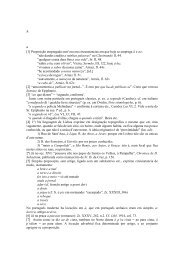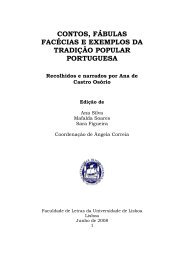1 Ana Maria Martins (University of Lisbon – FLUL/CLUL) Freie ...
1 Ana Maria Martins (University of Lisbon – FLUL/CLUL) Freie ...
1 Ana Maria Martins (University of Lisbon – FLUL/CLUL) Freie ...
You also want an ePaper? Increase the reach of your titles
YUMPU automatically turns print PDFs into web optimized ePapers that Google loves.
[B] Isso lhe digo eu todos os dias mas não lhe entra<br />
that him-DAT tell-1SG I all the days but not him enters<br />
na cabeça.<br />
in-the head<br />
‘That’s what I tell him every day, but it does not get into his head.’<br />
(9) [A] Estás cansada. Vai passar uns dias na praia.<br />
are-2SG tired. go-2SG spend some days in-the beach<br />
‘You’re tired! Go spend some days at the beach.’<br />
[B] Isso queria eu.<br />
that wanted I<br />
‘That’s what I wanted.’<br />
(10) [A] Ele tem muito jeito pró negócio.<br />
he has much ability for-the business<br />
‘He has a natural gift for business.’<br />
[B] Com esse jeito pró negócio me vendeu ele uma televisão<br />
with that ability for-the business me sold he a television<br />
avariada.<br />
broken<br />
‘It’s with that gift for business that he sold me a broken TV.’<br />
The core property <strong>of</strong> a contrastive focus is the addition <strong>of</strong> the speakers’ disagreeing<br />
attitude regarding what he knows or supposes to be the expectations/convictions <strong>of</strong> the hearer.<br />
This attitude is added to the basic denotation <strong>of</strong> the sentence. As such, this type <strong>of</strong> focus<br />
signals the contrast between the information given by the speaker and the information that,<br />
according to the speaker’s beliefs, is previously assumed by the hearer. (Cf. Zimmermann<br />
2007; Onea and Zimmermann 2011).<br />
(11) Zimmermann’s (2007) definition <strong>of</strong> contrastive focus<br />
[Contrastive focus marking indicates] a contrast between the information conveyed by<br />
the speaker in asserting α and the assumed expectation state <strong>of</strong> the hearer: the speaker<br />
marks the content <strong>of</strong> α as <strong>–</strong> in her view <strong>–</strong> unlikely to be expected by the hearer, thus<br />
preparing the scene for a swifter update <strong>of</strong> the common ground.<br />
2. CFF vs. Topicalization<br />
Tests to be used (cf. Hernanz and Brucart 1987, Zubizarreta 1999, Ambar 1992, Rouveret<br />
1992, Duarte 1997, and Cardoso 2010):<br />
A <strong>–</strong> Cleft-like interpretation;<br />
B <strong>–</strong> Clitic placement;<br />
C <strong>–</strong> Sensitivity to referential properties <strong>of</strong> fronted constituent;<br />
D <strong>–</strong> Subject-verb inversion;<br />
E <strong>–</strong> PP-preposing (when the PP is the complement <strong>of</strong> certain existential and light);<br />
F <strong>–</strong> Relative clause extraposition.<br />
4





